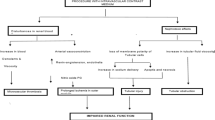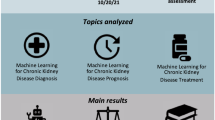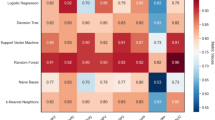Abstract
Purpose
To determine if ancillary sonographic and Doppler parameters can be used to predict transplant renal artery stenosis in patients with renal graft dysfunction.
Materials and methods
IRB-approved, HIPAA-compliant retrospective study included 80 renal transplant patients who had renal US followed by renal angiogram between January 2018 and December 2019. A consensus read of two radiologists recorded these parameters: peak systolic velocity, persistence of elevated velocity, grayscale narrowing, parvus tardus, delayed systolic upstroke, angle of the systolic peak (SP angle), and aliasing. Univariate analysis using t-test or chi-square was performed to determine differences between patients with and without stenosis. P values under 0.05 were deemed statistically significant. We used machine learning algorithms to determine parameters that could better predict the presence of stenosis. The algorithms included logistic regression, random forest, imbalanced random forest, boosting, and CART. All 80 cases were split between training and testing using stratified sampling using a 75:25 split.
Results
We found a statistically significant difference in grayscale narrowing (p = 0.0010), delayed systolic upstroke (p = 0.0002), SP angle (p = 0.0005), and aliasing (p = 0.0024) between the two groups. No significant difference was found for an elevated peak systolic velocity (p = 0.1684). The imbalanced random forest (IRF) model was selected for improved accuracy, sensitivity, and specificity. Specificity, sensitivity, AUC, and normalized Brier score for the IRF model using all parameters were 73%, 81%, 0.82, and 69 in the training set, and 78%, 58%, 0.78, and 80 in the testing set. VIMP assessment showed that the combination of variables that resulted in the most significant change of the training set performance was that of grayscale narrowing and SP angle.
Conclusion
Elevated peak systolic velocity did not discriminate between patients with and without TRAS. Adding ancillary parameters into the machine learning algorithm improved specificity and sensitivity similarly in the training and testing sets. The algorithm identified the combination of lumen narrowing coupled with the angle of the systolic peak as better predictor of TRAS. This model may improve the accuracy of ultrasound for transplant renal artery stenosis.




Similar content being viewed by others
References
Hurst, F. P., Abbott, K. C., Neff, R. T., Elster, E. A., Falta, E. M., Lentine, K. L., Agodoa, L. Y., & Jindal, R. M. (2009). Incidence, predictors and outcomes of transplant renal artery stenosis after kidney transplantation: analysis of USRDS. American journal of nephrology, 30(5), 459–467. https://doi.org/10.1159/000242431
Patel, U., Khaw, K. K., & Hughes, N. C. (2003). Doppler ultrasound for detection of renal transplant artery stenosis-threshold peak systolic velocity needs to be higher in a low-risk or surveillance population. Clinical radiology, 58(10), 772–777. https://doi.org/10.1016/s0009-9260(03)00211-3
Bruno, S., Remuzzi, G., & Ruggenenti, P. (2004). Transplant renal artery stenosis. Journal of the American Society of Nephrology : JASN, 15(1), 134–141. https://doi.org/10.1097/01.asn.0000099379.61001.f8
Mangray, M., & Vella, J. P. (2011). Hypertension after kidney transplant. American journal of kidney diseases: the official journal of the National Kidney Foundation, 57(2), 331–341. https://doi.org/10.1053/j.ajkd.2010.10.048
de Morais, R. H., Muglia, V. F., Mamere, A. E., Garcia Pisi, T., Saber, L. T., Muglia, V. A., Elias, J., Jr, Piccinato, C. E., & Trad, C. S. (2003). Duplex Doppler sonography of transplant renal artery stenosis. Journal of clinical ultrasound : JCU, 31(3), 135–141. https://doi.org/10.1002/jcu.10147
Akbar, S. A., Jafri, S. Z., Amendola, M. A., Madrazo, B. L., Salem, R., & Bis, K. G. (2005). Complications of renal transplantation. Radiographics: a review publication of the Radiological Society of North America, Inc, 25(5), 1335–1356. https://doi.org/10.1148/rg.255045133
Robinson, K. A., Kriegshauser, J. S., Dahiya, N., Young, S. W., Czaplicki, C. D., & Patel, M. D. (2017). Detection of transplant renal artery stenosis: determining normal velocities at the renal artery anastomosis. Abdominal radiology (New York), 42(1), 254–259. https://doi.org/10.1007/s00261-016-0876-7
Loubeyre, P., Abidi, H., Cahen, R., & Tran Minh, V. A. (1997). Transplanted renal artery: detection of stenosis with color Doppler US. Radiology, 203(3), 661–665. https://doi.org/10.1148/radiology.203.3.9169685
Luna C, Hassan F, Scortegagna E, Castillo RP. Analysis of the Peak Systolic Velocity in the Transplant Renal Artery Anastomosis to Determine Normal Values in Patients Without Graft Dysfunction. Journal of Diagnostic Medical Sonography. 2022;38(1):36-43. https://doi.org/10.1177/87564793211029897
Kotval P. S. (1989). Doppler waveform parvus and tardus. A sign of proximal flow obstruction. Journal of ultrasound in medicine: official journal of the American Institute of Ultrasound in Medicine, 8(8), 435–440. https://doi.org/10.7863/jum.1989.8.8.435
Rubin J. M. (1995). In Doppler sonography, what is aliasing, and how does it help detect vascular stenosis? AJR. American journal of roentgenology, 165(4), 1003–1004. https://doi.org/10.2214/ajr.165.4.7676944
Rajan, D. K., Stavropoulos, S. W., & Shlansky-Goldberg, R. D. (2004). Management of transplant renal artery stenosis. Seminars in interventional radiology, 21(4), 259–269. https://doi.org/10.1055/s-2004-861560
Moresco, K. P., Patel, N. H., Namyslowski, Y., Shah, H., Johnson, M. S., & Trerotola, S. O. (1998). Carbon dioxide angiography of the transplanted kidney: technical considerations and imaging findings. AJR. American journal of roentgenology, 171(5), 1271–1276. https://doi.org/10.2214/ajr.171.5.9798859
Sharma, S., Potdar, A., & Kulkarni, A. (2011). Percutaneous transluminal renal stenting for transplant renal artery stenosis. Catheterization and cardiovascular interventions : official journal of the Society for Cardiac Angiography & Interventions, 77(2), 287–293. https://doi.org/10.1002/ccd.22758
Fananapazir G, LaRoy JR, Navarro SM, Corwin MT, Carney B, Troppmann C. Ultrasound Screening for Transplant Renal Artery Stenosis Risk Stratification Using Standardized Criteria in Structured Reporting: A Validation Study. J Ultrasound Med. 2022;41(6):1433-1438. https://doi.org/10.1002/jum.15826
Siskind E, Lombardi P, Blum M, et al. Significance of elevated transplant renal artery velocities in the postoperative renal transplant patient. Clin Transplant. 2013;27(2):E157-E160. https://doi.org/10.1111/ctr.12075
Granata, A., Clementi, S., Londrino, F., Romano, G., Veroux, M., Fiorini, F., & Fatuzzo, P. (2014). Renal transplant vascular complications: the role of Doppler ultrasound. Journal of ultrasound, 18(2), 101–107. https://doi.org/10.1007/s40477-014-0085-6
Brabrand, K., Holdaas, H., Gunther, A., & Midtvedt, K. (2011). Spontaneous regression of initially elevated peak systolic velocity in renal transplant artery. Transplant international: official journal of the European Society for Organ Transplantation, 24(6), 555–559. https://doi.org/10.1111/j.1432-2277.2011.01233.x
Brown, E. D., Chen, M. Y., Wolfman, N. T., Ott, D. J., & Watson, N. E., Jr (2000). Complications of renal transplantation: evaluation with US and radionuclide imaging. Radiographics : a review publication of the Radiological Society of North America, Inc, 20(3), 607–622. https://doi.org/10.1148/radiographics.20.3.g00ma14607
Sugi, M. D., Joshi, G., Maddu, K. K., Dahiya, N., & Menias, C. O. (2019). Imaging of renal transplant complications throughout the life of the allograft: comprehensive multimodality review. Radiographics: A Review Publication of the Radiological Society of North America, Inc, 39(5), 1327–1355. https://doi.org/10.1148/rg.2019190096
Kronick, M. D., Chopra, A., Swamy, S., Brar, V., Jung, E., Abraham, C. Z., Liem, T. K., Landry, G. J., & Moneta, G. L. (2020). Peak systolic velocity and color aliasing are important in the development of duplex ultrasound criteria for external carotid artery stenosis. Journal of vascular surgery, 72(3), 951–957. https://doi.org/10.1016/j.jvs.2019.10.099
Trusen, A., Beissert, M., & Hahn, D. (2003). Color Doppler US findings in the diagnosis of arterial occlusive disease of the lower limb. Acta radiologica (Stockholm, Sweden : 1987), 44(4), 411–418. https://doi.org/10.1034/j.1600-0455.2003.00087.x
Gottlieb, R. H., Lieberman, J. L., Pabico, R. C., & Waldman, D. L. (1995). Diagnosis of renal artery stenosis in transplanted kidneys: value of Doppler waveform analysis of the intrarenal arteries. AJR. American journal of roentgenology, 165(6), 1441–1446. https://doi.org/10.2214/ajr.165.6.7484582
Kliewer, M. A., Tupler, R. H., Hertzberg, B. S., Paine, S. S., DeLong, D. M., Svetkey, L. P., & Carroll, B. A. (1994). Doppler evaluation of renal artery stenosis: interobserver agreement in the interpretation of waveform morphology. AJR. American journal of roentgenology, 162(6), 1371–1376. https://doi.org/10.2214/ajr.162.6.8192002
Richardson, D., Foster, J., Davison, A. M., & Irving, H. C. (2000). Parvus tardus waveform suggesting renal artery stenosis-remember the more proximal stenosis. Nephrology, dialysis, transplantation : official publication of the European Dialysis and Transplant Association - European Renal Association, 15(4), 539–543. https://doi.org/10.1093/ndt/15.4.539
Stavros, A. T., Parker, S. H., Yakes, W. F., Chantelois, A. E., Burke, B. J., Meyers, P. R., & Schenck, J. J. (1992). Segmental stenosis of the renal artery: pattern recognition of tardus and parvus abnormalities with duplex sonography. Radiology, 184(2), 487–492. https://doi.org/10.1148/radiology.184.2.1620853
Lin SY, Law KM, Yeh YC, et al. Applying Machine Learning to Carotid Sonographic Features for Recurrent Stroke in Patients With Acute Stroke. Front Cardiovasc Med. 2022;9:804410. Published 2022 Jan 28. https://doi.org/10.3389/fcvm.2022.804410
Funding
No financial disclosure or competing interests.
Author information
Authors and Affiliations
Corresponding author
Additional information
Publisher's Note
Springer Nature remains neutral with regard to jurisdictional claims in published maps and institutional affiliations.
Rights and permissions
Springer Nature or its licensor (e.g. a society or other partner) holds exclusive rights to this article under a publishing agreement with the author(s) or other rightsholder(s); author self-archiving of the accepted manuscript version of this article is solely governed by the terms of such publishing agreement and applicable law.
About this article
Cite this article
Blain, Y., Alessandrino, F., Scortegagna, E. et al. Transplant renal artery stenosis: utilization of machine learning to identify ancillary sonographic and doppler parameters to predict stenosis in patients with graft dysfunction. Abdom Radiol 48, 2102–2110 (2023). https://doi.org/10.1007/s00261-023-03872-7
Received:
Revised:
Accepted:
Published:
Issue Date:
DOI: https://doi.org/10.1007/s00261-023-03872-7




